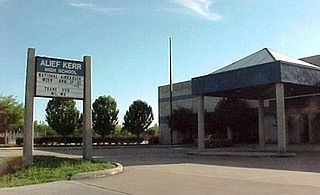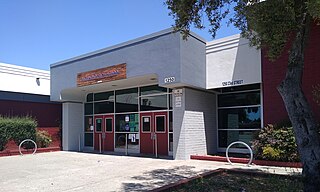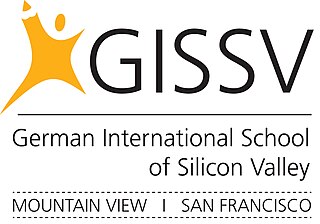
Berkeley is a city on the eastern shore of San Francisco Bay in northern Alameda County, California, United States. It is named after the 18th-century Anglo-Irish bishop and philosopher George Berkeley. It borders the cities of Oakland and Emeryville to the south and the city of Albany and the unincorporated community of Kensington to the north. Its eastern border with Contra Costa County generally follows the ridge of the Berkeley Hills. The 2020 census recorded a population of 124,321.
Achievement gaps in the United States are observed, persistent disparities in measures of educational performance among subgroups of U.S. students, especially groups defined by socioeconomic status (SES), race/ethnicity and gender. The achievement gap can be observed through a variety of measures, including standardized test scores, grade point average, dropout rates, college enrollment, and college completion rates. The gap in achievement between lower income students and higher income students exists in all nations and it has been studied extensively in the U.S. and other countries, including the U.K. Various other gaps between groups exist around the globe as well.

The Preuss School, Preuss School UCSD, or Preuss Model School is a coeducational college-preparatory charter day school established on a $14 million campus situated on the University of California San Diego (UCSD) campus in the La Jolla community of San Diego, California. The school was named in recognition of a gift from the Preuss Family Foundation and is chartered under the San Diego Unified School District (SDUSD).
Cypress Creek High School, also known as Cy Creek, is a secondary public school located in unincorporated Harris County, Texas, United States. Cypress Creek, which serves grades 9 through 12, is a part of the Cypress-Fairbanks Independent School District.
The Berkeley Unified School District (BUSD) is the public school district for the city of Berkeley, California, United States. The district is managed by the Superintendent of Schools, and governed by the Berkeley Board of Education, whose members are elected by voters. Its administrative offices are located in the old West Campus main building at 2020 Bonar Street, on the corner of Bonar and University Avenue.

Alief Kerr High School is an Alief ISD public school located in the Alief community, and in the limited purpose city limits of Houston, Texas, United States. The school is a part of the Alief Independent School District and serves grades 9 through 12.

James A. Garfield High School is a year-round public high school founded in 1925 in East Los Angeles, an unincorporated section of Los Angeles County, California. At Garfield, 38% of students participate in advanced placement programs. Approximately 93% of the student population comes from disadvantaged backgrounds with limited financial or social opportunities. The school maintains a comprehensive minority admission policy with a 100% minority population.

Richmond High School (RHS) is a secondary school located in Richmond, California, United States. It is part of the West Contra Costa Unified School District (WCCUSD) and serves half of North Richmond and San Pablo.

College of Alameda is a public community college in Alameda, California. It is part of the Peralta Community College District and was opened in 1968. Since 1970 the college has held classes on a 62-acre campus at the intersection of Webster Street and Ralph Appezzato Memorial Parkway in Alameda.
Oppositional culture, also known as the "blocked opportunities framework" or the "caste theory of education", is a term most commonly used in studying the sociology of education to explain racial disparities in educational achievement, particularly between white and black Americans. However, the term refers to any subculture's rejection of conformity to prevailing norms and values, not just nonconformity within the educational system. Thus many criminal gangs and religious cults could also be considered oppositional cultures.
Educational inequality is the unequal distribution of academic resources, including but not limited to school funding, qualified and experienced teachers, books, and technologies, to socially excluded communities. These communities tend to be historically disadvantaged and oppressed. Individuals belonging to these marginalized groups are often denied access to schools with adequate resources. Inequality leads to major differences in the educational success or efficiency of these individuals and ultimately suppresses social and economic mobility. Inequality in education is broken down into different types: regional inequality, inequality by sex, inequality by social stratification, inequality by parental income, inequality by parent occupation, and many more.

As an educational reform goal, class size reduction (CSR) aims to increase the number of individualized student-teacher interactions intended to improve student learning. A reform long holding theoretical attraction to many constituencies, some have claimed CSR as the most studied educational reform of the last century. Until recently, interpretations of these studies have often been contentious. Some educational groups like the American Federation of Teachers and National Education Association are in favor of reducing class sizes. Others argue that class size reduction has little effect on student achievement. Many are concerned about the costs of reducing class sizes.
The National Equity Project, formerly known as the Bay Area Coalition for Equitable Schools or BayCES, is an education reform organization that specializes in leadership development and changing culture and conditions in order to further equity objectives. It is a coaching and consulting organization based in Oakland, California; its name change in July 2010. The name was changed as the organization had expanded into new regions and began offering new services. In addition to schools, they also work with many districts and nonprofits on educational equity initiatives.

American Indian Model Schools is a charter school system based in Oakland, California. Started with the American Indian Public Charter School (AIPCS), a middle school in the late 1990s to serve Native American students, in 2007 it expanded to include another middle school and a high school. The main campus is in the Laurel area and includes AIPCS, a middle school of grades 5–8, and American Indian Public High School (AIPHS), a high school (9–12). AIPHS students can also take select classes at Merritt College. American Indian Public Charter School II has grades K–8 at a second campus located in Oakland's Chinatown. By 2012 the student population of the AIM schools had become 90% Asian American.
The racial achievement gap in the United States refers to disparities in educational achievement between differing ethnic/racial groups. It manifests itself in a variety of ways: African-American and Hispanic students are more likely to earn lower grades, score lower on standardized tests, drop out of high school, and they are less likely to enter and complete college than whites, while whites score lower than Asian Americans.
Project SEED is a mathematics education program which worked in urban school districts across the United States. Project SEED is a nonprofit organization that worked in partnership with school districts, universities, foundations, and corporations to teach advanced mathematics to elementary and middle school students as a supplement to their regular math instruction. Project SEED also provides professional development for classroom teachers. Founded in 1963 by William F. Johntz, its primary goal is to use mathematics to increase the educational options of low-achieving, at-risk students.

The German International School of Silicon Valley (GISSV) is a private school educating children from preschool to grade 12 using bilingual full immersion. It has sites in Mountain View and San Francisco in California. Students graduate the school with both the German International Abitur and the California High School Diploma. The school is accredited with the Western Association of Schools (WASC), as well as the California Association of Independent Schools (CAIS) and by the German government as an official German School Abroad.
Valor Christian Academy is a private transitional kindergarten through middle grades Christian school in Redondo Beach, California, in the Los Angeles metropolitan area. It was previously known as Coast Christian School but received its current name in September 2012. It was affiliated with the Assemblies of God.

Unequal access to education in the United States results in unequal outcomes for students. Disparities in academic access among students in the United States are the result of several factors including: government policies, school choice, family wealth, parenting style, implicit bias towards the race or ethnicity of the student, and the resources available to the student and their school. Educational inequality contributes to a number of broader problems in the United States, including income inequality and increasing prison populations. Educational inequalities in the United States are wide-ranging, and many potential solutions have been proposed to mitigate their impacts on students.
Gilda Laura Ochoa is an American sociologist and professor. She is Professor of Chicana/o-Latina/o studies at Pomona College in the United States, and the author of Academic Profiling: Latinos, Asian Americans, and the Achievement Gap.
















